Astronomers all over are waiting with bated breath to see what Betelgeuse will do next. Is it going to start brightening again on February 21st? Or will it continue to surprise?
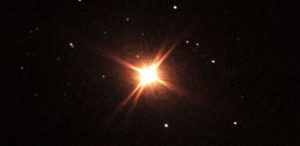
Michael J. Boyle
Astronomer Edward Guinan of Villanova University has given Betelgeuse an ultimatum of sorts. Guinan, who has closely tracked the star's brightness for the past 25 years, predicts that the supergiant will reach minimum brightness on February 21st, plus or minus a week. In fact, Betelgeuse-watchers have noticed that the rate of dimming has slowed in recent days which may be a sign that an upturn is just around the corner.
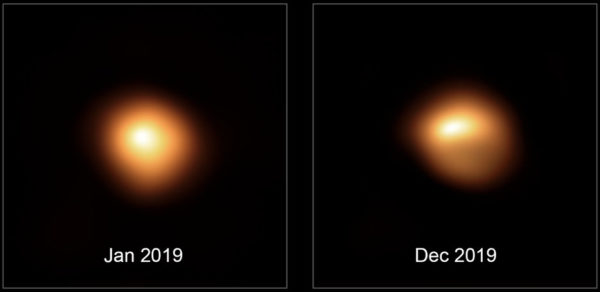
New before and after photos taken by SPHERE (Spectro-Polarimetric High-contrast Exoplanet REsearch Instrument) on the European Southern Observatory’s Very Large Telescope (VLT) show not only how much the star has faded but also that its shape has changed. A team led by astronomer Miguel Montargès, of KU Leuven in Belgium, has been observing the star since December with the VLT and released these stunning images just today (February 14th). Montargès suspects that Betelgeuse's dramatic fading may be due either a cooling of the surface or dust ejected by the star in our direction.
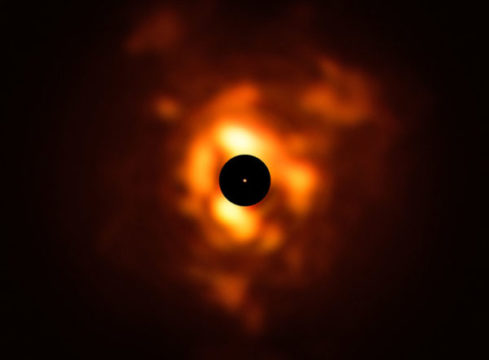
Credit: ESO/P. Kervella/M. Montargès et al., Acknowledgement: Eric Pantin
Dust is a great absorber of starlight, and Betelgeuse with its powerful stellar winds produces oodles of the stuff. This dust fills an enormous circumstellar shell that dwarfs the star itself. A massive red supergiant like Betelgeuse possesses a relatively cool atmosphere in which elements forged by the star combine to form the chemical compounds that make up the dust. Astronomers have identified water, silicon monoxide, and aluminum oxide among other molecules in the star's effluent.
Amateur and professional astronomers around the planet have kept a close watch on Betelgeuse during its dramatic "fainting" over the past several months. For some it's more like a deathwatch. I've run into more than a few people expecting or hoping that the famous supergiant will explode as a supernova. Hold your horses! We'd all like to be dazzled by a –11 magnitude supernova, I tell them, but we just don't know enough to start circling dates on a calendar.
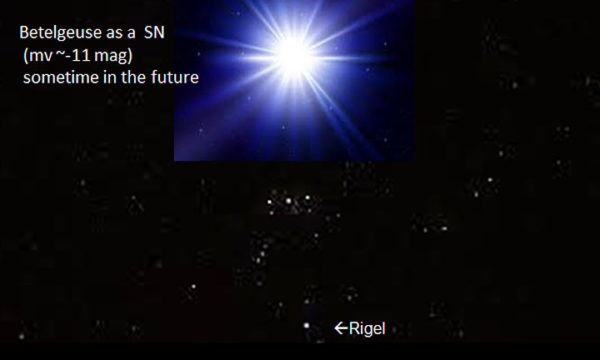
Edward Guinan
Betelgeuse has remained around magnitude 1.6 (or 1.7 by my visual estimate) for the past couple weeks. Gazing at the star these February nights, it's hard to believe that at peak brightness it can outshine its fellow luminary Rigel. At the moment, Betelgeuse and its mate Bellatrix (magnitude 1.6) are virtually equal in brightness, while Aldebaran (0.9) in nearby Taurus overpowers the supergiant by three-quarters of a magnitude. Guinan's photometric observations over the past week show Betelgeuse at around 1.60 to 1.62 — the least luminous and coolest yet measured during 25 years of photometry.
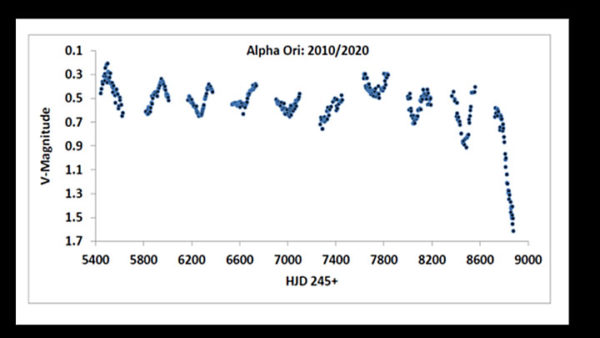
Edward Guinan
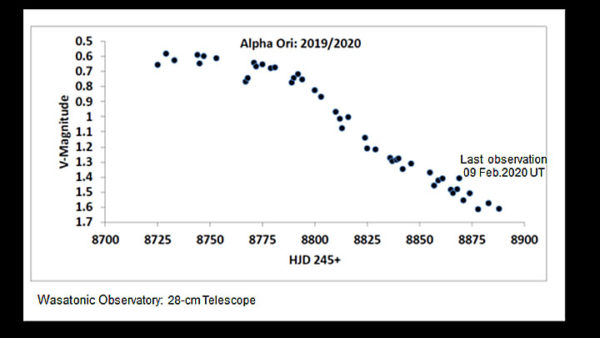
Ed Guinan
Light variations on Betelgeuse arise in several ways: the aforementioned episodes of dust ejection; physical pulsations that cause the star to expand and contract at regular and irregular intervals and darkening caused by jumbo-sized starspots on the star's surface. Guinan bases the February 21st date on the star's dominant pulsation period of 430 days, which arrives on or about that date.
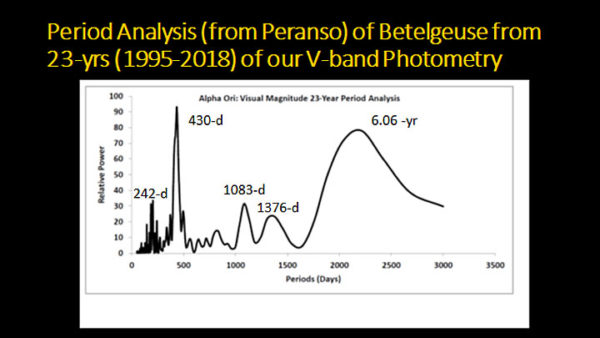
Courtesy of Edward Guinan
An analysis of Betelgeuse's light variations reveals evidence for multiple periods of variation from as brief as around 242 days to as long as 6.06 years. It's a splendid mess and the reason more and more professional astronomers are scrutinizing it with every instrument they can get their hands on.
Guinan and a team other other scientists were recently awarded time to observe the supergiant with NASA's Stratospheric Observatory for Infrared Astronomy (SOFIA) in mid-infrared high-resolution spectroscopy. Many more efforts are underway including but not limited to Hubble Space Telescope near-infrared observations, 22-GHz and 15-GHz radio studies with e-MERLIN (the enhanced Multi Element Remotely Linked Interferometer Network), and the Arcminute Microkelvin Imager (AMI), along with interferometric measurements (to determine the star's size and shape) using VLTI-SPHERE and CHARA.
Your efforts count, too! Amateur astronomers like you have contributed hundreds of recent visual, CCD, and photoelectric observations of the star to the American Association of Variable Star Observers (AAVSO).
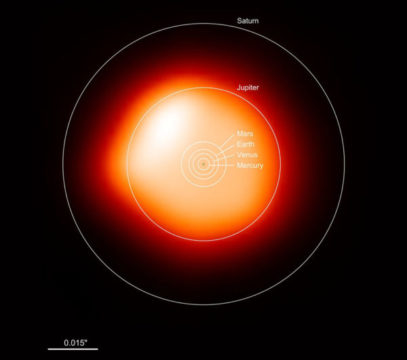
ESO
Betelgeuse remains in view until May, so there's lots of time for the star to either resume its routine or confound us with more surprises. We all have a front seat at this show. Walter Webb of the Red River Astronomy Club in Texas wonders if NASA might be able to use the Mars Curiosity Rover to extend observations of the star though solar conjunction from Gale Crater. Great suggestion!
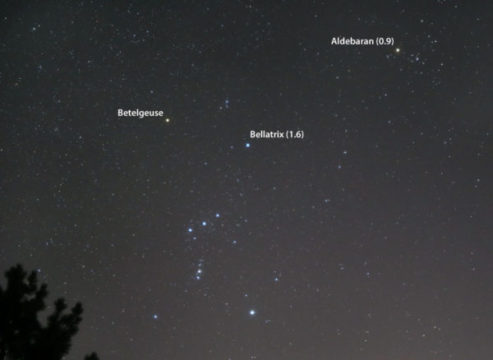
Bob King
One thing is clear: Betelgeuse called out, and now we're listening with every ounce of ingenuity we can muster. And if you're still hungry for a supernova, have a look at SN 2020 ue in NGC 4636 in Virgo. It still shines around magnitude 12, an easy catch in an 8-inch or larger telescope. Click here for a finder chart and more information.
 0
0







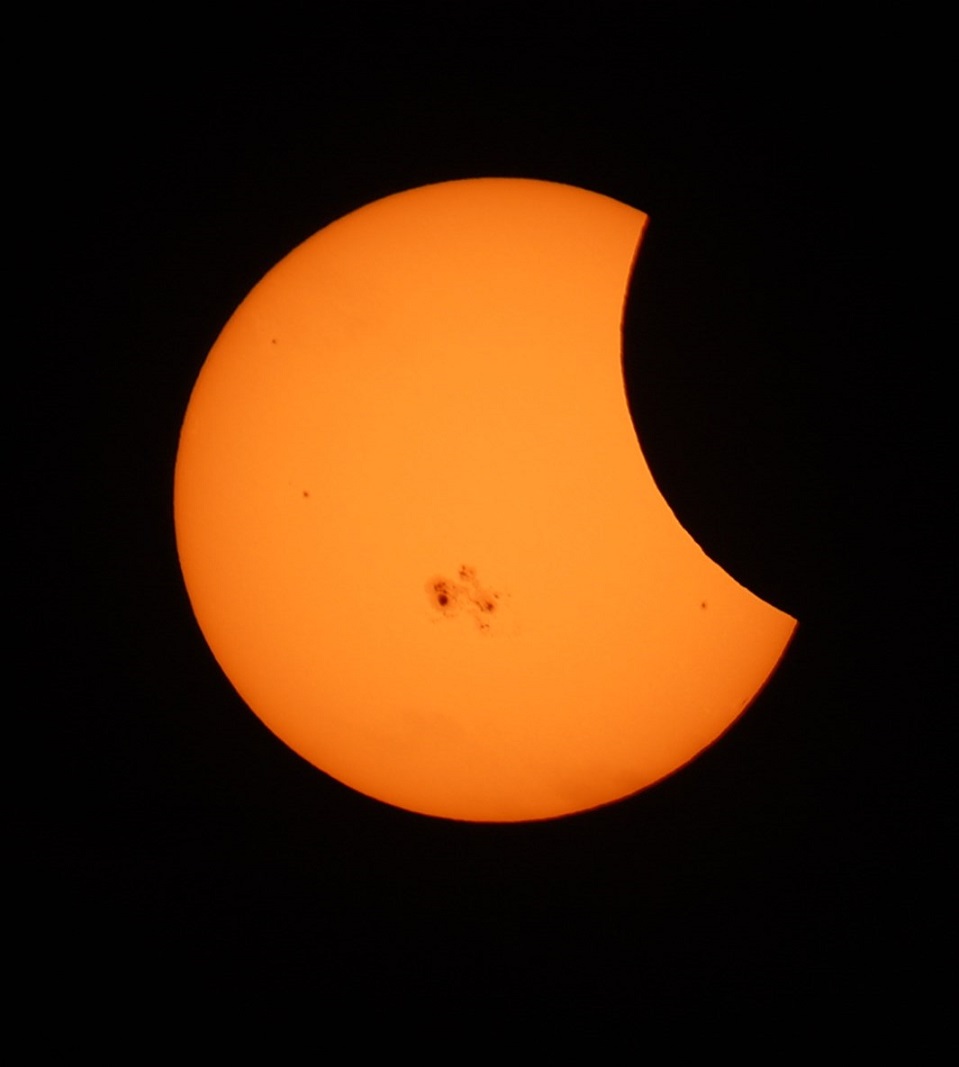

Comments
sternenmann
February 14, 2020 at 6:20 pm
Fascinating development indeed! A small correction: SPHERE is not an instrument on the ESO VLTI but an extreme adaptive optics instrument on the Nasmyth A focus of one of the four 8m unit telescopes of the VLT (UT3 = Melipal). The VLTI, combining the four UTs, should deliver even higher resolution (approx. 100m equivalent diameter).
You must be logged in to post a comment.
Bob KingPost Author
February 14, 2020 at 7:06 pm
Hi Sternenmann,
Thank you for your comment. The caption with the SPHERE information was taken directly from the European Southern Observatory (ESO) press release and is correct according to the release. It's possible whoever crafted the original release made an error or chose to simplify the description for public consumption.
You must be logged in to post a comment.
Tom-Reiland
February 14, 2020 at 8:15 pm
I agree with your magnitude estimate of Betelgeuse at 1.7 magnitude, Bob. This the first night in a week that it has been clear enough to make any observations in Western Pennsylvania. Two points concerning the possibility of Betelgeuse becoming a Supernova in the very near future: As much as I would love to see a daytime, naked-eye SN, I would hate to see the right shoulder of Orion eventually fade away. Second, if it does occur, I hope that it will be in Mid-April so that it does not interfere with Deep Sky observing for more than an hour or two in the Spring evenings. To date, I have observed 113 SNs in other galaxies. I would love to see one in the Milky Way.
You must be logged in to post a comment.
misha17
February 14, 2020 at 9:16 pm
I just went out to see which star - Betelgues or Bellatrix - appeared first in the bright evening twilight. Aldebaran and Rigel, and Sirius were already visible, which gave me points of reference where to search.
I used Aldebaran and Sirius to get a rough idea of where Orion's Belt should be (the Belt points up to Aldebaran and down to Sirius), and looked above Rigel along the A-OB-S line to get an idea of where Bellatrix should be. I noticed Bellatrix and Betelguese came in to view at about the same time, but Betelguese seemed to stand out a little more in the twilight sky. I don't think the sky near Bellatrix - being a little nearer to where the sun had set - was appreciably brighter to affect the comparison.
You must be logged in to post a comment.
KCIndy
February 15, 2020 at 3:50 am
Dust cloud!
I call dust cloud!!!
You must be logged in to post a comment.
Bob KingPost Author
February 15, 2020 at 1:41 pm
K,
Hopefully we'll know soon. I suspect a combination of dust and intrinsic fading due to pulsations.
You must be logged in to post a comment.
John Asztalos
February 15, 2020 at 1:10 pm
It's mentioned that Betelgeuse will be visible until May. And, maybe from the Curiosity rover. Well, it will be visible from Antarctica also.
You must be logged in to post a comment.
Bob KingPost Author
February 15, 2020 at 1:40 pm
Hi John,
Yes — Antarctica, too! I didn't mention a specific part of the globe because Orion and Betelgeuse will be visible from many locations into May. However Betelgeuse won't be visible from Antarctica (or anywhere else for that matter) in June and July because it will be lost in the solar glare.
You must be logged in to post a comment.
Howard Ritter
February 15, 2020 at 2:37 pm
The Principle of Astrophysical Universal Coincidental Infelicity (PAUCIty) guarantees that if Betelgeuse goes SN, it will do so shortly after entering its period of invisibility near the Sun.
You must be logged in to post a comment.
Jim-Baughman
February 15, 2020 at 2:48 pm
There is a corollary to that principle which states that anything you drop anywhere in a room, no matter how sparsely furnished, will end up hidden under something 87.34% of the time.
You must be logged in to post a comment.
Tom Hoffelder
February 15, 2020 at 9:03 pm
I was going to say something like that but then saw your PAUCIty. Nice! Much more general than my: Hoffelder's corollary (to Murphy's Law), rev 2: The probability of cloud cover at night is a) inversely proportional to the amount of moonlight in the sky, and b) directly proportional to the observer's level of interest in any celestial event, with the latter taking precedence when applicable.
You must be logged in to post a comment.
Jim-Baughman
February 15, 2020 at 2:45 pm
Now that Betelgeuse has the world’s attention nothing will happen … haha!
But seriously, would it be possible to go back and examine images of the progenitor star of SN 1987A to look for similar plunges in the star’s magnitude prior to its explosion? I know magnitude would be difficult to measure at that distance, but it might be possible, and there are probably enough images of that region of the sky prior to detonation to make an attempt worthwhile.
You must be logged in to post a comment.
Dmitriusz
February 20, 2020 at 4:46 am
In 2003 past photometric behaviour of the progenitor of SN 1987A was investigated for possible variability on a large sample of photographic plates at the Harvard Observatory covering the time period of 1896-1954. No variability of the star was found at the 0.3-magnitude level.
The results are described in article "Photometry of SK-69°202, the Progenitor of SN 1987A from 1896 to 1954" ( http://articles.adsabs.harvard.edu/pdf/2004JAVSO..32...89P )
But SN 1987A was extremely anomalous Supernova and its progenitor - blue supergiant of B3Ia class - also was unexpected from theoretical point of view...
You must be logged in to post a comment.
goodricke1
February 21, 2020 at 4:20 pm
That link is not available
You must be logged in to post a comment.
RMP
February 15, 2020 at 8:24 pm
I'm a bit surprised to see only 10 yrs. of photometric data of Betelegeuse. Are photometric and visual data going back earlier into the 20th century that might show how regular the multiple variations and dimming?
You must be logged in to post a comment.
Bob KingPost Author
February 15, 2020 at 8:58 pm
Hi Ron,
Guinan's data go back 25 years and reveal this as the faintest minimum during that time. But the AAVSO goes back much further to 1893 (visual of course) and photoelectric to about the 1920s. No other fainter minimum has been recorded, but there have been several similar dips though not quite as deep. Check my earlier blog on the topic: https://www.skyandtelescope.com/observing/fainting-betelgeuse/
You must be logged in to post a comment.
RMP
February 16, 2020 at 5:06 pm
thanks Bob!
You must be logged in to post a comment.
Tom Hoffelder
February 15, 2020 at 9:22 pm
Last night I could not tell any magnitude difference between Betelgeuse and Bellatrix, so submitted an estimate of 1.6 to AAVSO. If you look at the submitted visual data, it ranges from 1.3 to 1.9. I guess the large range of visual estimates is because what each person sees is based on a number of variables, like sky conditions and individual color perception, especially when the variable star is so red.
You must be logged in to post a comment.
Dmitriusz
February 17, 2020 at 10:12 am
This winter we have cloudy sky almost all the time - so I can made only few estimates of Betelgeuze's brightness. My recent observations from severe polluted city skies are 1.7 mag in February 8 evening and 1.8 mag in February 9.
Winter Hexagon is strikingly changing!
You must be logged in to post a comment.
Spencernash
February 18, 2020 at 2:25 am
Thanks
You must be logged in to post a comment.
Bob
February 19, 2020 at 11:48 pm
Bob King,
Nice article with several good images. I think my favorite is the next to last image showing the relative size of Betelgeuse -- reaching from our Sun to beyond planet Jupiter.
Thank you.
Bob
Kentucky
You must be logged in to post a comment.
robbie
February 21, 2020 at 11:28 am
Hello Bob - firstly, thanks for your wonderful blog. We've had clear skies in Scotland for three nights now, and my sad(!) view is that Betelgeuse seems to be getting brighter - looking at twilight, when Bellatrix and Betelgeuse were barely visible, Betelgeuse had the edge, and that appears true in full darkness too. Regards, Robbie
You must be logged in to post a comment.
Bob KingPost Author
February 22, 2020 at 8:48 pm
Thanks, Robbie! Thanks for sharing your observation. I also looked at Betelgeuse (Feb. 21.1 UT) and I thought it still appeared a bit fainter than Bellatrix.
You must be logged in to post a comment.
You must be logged in to post a comment.